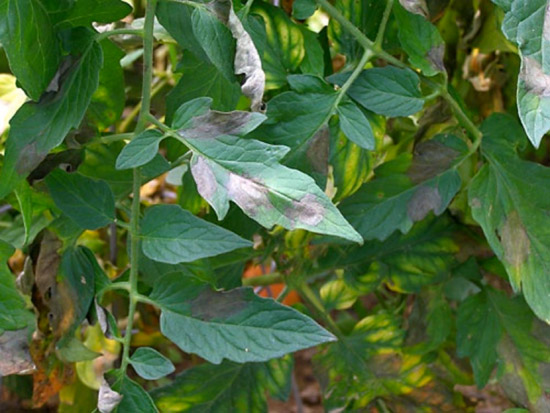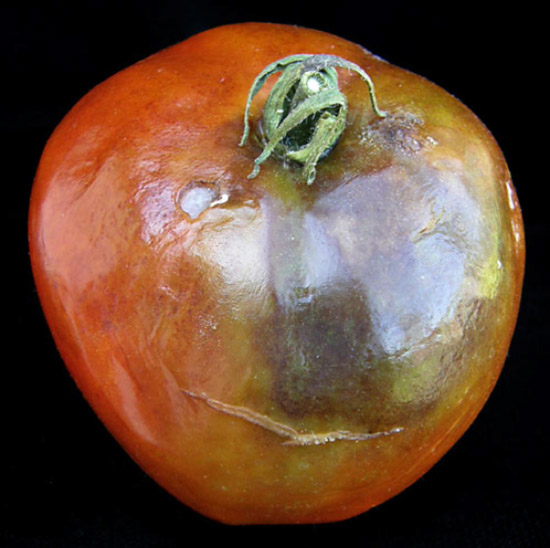Issue 15, September 9, 2013
Late Blight (Phytophthora infestans) found on Tomato in Illinois.
Several weeks ago, Purdue University reported tomato infection by Phytophthora infestans, which causes the disease known as Late Blight. More recently, the U of I Plant Clinic received a tomato sample from Northern Illinois also found to be infected with this pathogen. Phytophthora infestans was first reported in Europe in 1845 and is more famously associated with the Irish potato famine. In most cases, potato crops are more at risk to be infected by this disease, because infested tubers provide the main source of initial inoculum. In recent years, this disease has been a problem in Florida and sporadically in Northeastern United States. In the Northeastern U.S., tomato and potato are commonly grown together and form a "green bridge" contributing the spread of the late blight pathogen. Historically, this disease has not been a problem in Illinois.
Through chance mutation or recombination during sexual reproduction, Phytophthora infestans can produce multiple genotypes that may vary in aggressiveness on tomato and potato. For example, they have found that one genotype may only affect potato, while other genotypes may be more aggressive on tomato. Fortunately, this variation allows for easier control of this disease. Government funding has led to the recent investigation of late blight. Through this project, several existing and new genotypes of Phytophthora infestans have been documented in the Northeastern US.
This pathogen can be devastating in cool, rainy weather, as it thrives in a wet, humid environment. However, this disease has continuously developed several weeks later than normal (in May) in Florida, which suggests that there may be a genotype that is able to tolerate warmer temperatures. Typically, this disease can appear from August through October in the Northeastern US.
Phytophthora infestans is an obligate parasite, and currently only known to survive in the US on living host plant tissue or tubers. The type of pathogen reproduction varies based on mating types present. If only one pathogen mating type is present, asexual reproduction occurs. This results in the development of fuzzy fungal growth on affected tissue that yield wind dispersed spores (sporangia containing zoospores). If both mating types are present, sexual reproduction takes place and oospores are produced. Oospores can survive in the absence of host tissue and in the presence of adverse conditions in the soil. If both mating types of this pathogen become established in the north, late blight could become a very common disease and have a profound impact on tomato and potato production (especially organic).
This pathogen can infect both young and old foliage. The first symptom to appear will be rapidly enlarging water soaked areas that will form into irregularly shaped greenish black blotches with a "frosted" appearance. The undersides of leaves can have a downy white growth when wet. Foliage can be quickly killed, especially above points where stems have been infected. Fruits can also be infected, developing irregular shaped brown blotches before deteriorating rapidly. Depending on favorable conditions and genotype virulence, the infection can quickly progress within 4 to 7 days. This rapid disease progression can cause crop loss and disease epidemics.

Photo provided by Dr. M. Babadoost

Photo provided by Dr. M. Babadoost
If a preventative disease management approach is not taken, this disease will be extremely difficult to control. Luckily, a large, five year, national project with government funding was started to investigate late blight, monitor pathogen genotypes, and improve management by developing resistant varieties and a monitoring program. The project web site is http://usablight.org/. Successful management of late blight includes the following: Scouting, early detection by a Plant Clinic, destruction of infected plant material (tomatoes, potatoes, and susceptible weeds), monitoring of favorable conditions, and weekly protective fungicide application. Research is ongoing to control late blight in organic tomato and potato production. Unfortunately, the late blight pathogen has demonstrated that it has developed resistance to fungicides and resistant plant varieties. (Stephanie Porter)
This article was based on Late Blight: Recent Occurrences, Challenges, and Future Outlook (2013) (Adobe PDF) by Margaret Tuttle McGrath, Cornell University.
Author:
Stephanie Porter